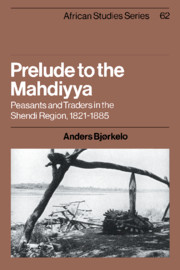Book contents
- Frontmatter
- Contents
- Figures
- List of maps
- List of tables
- Preface
- Acknowledgements
- Abbreviations
- Weights and measures
- The Sudan in the nineteenth century
- Introduction
- 1 The Ja'alī Kingdom of Shendi and its destruction
- 2 Shendi's economy on the eve of the Turkiyya
- 3 The Ja'aliyyīn under Turkish administration
- 4 The transformation of agriculture
- 5 Taxation
- 6 The transformation of commerce
- 7 Conclusion: dispersion and return
- Appendix: Three contracts from the archive of 'Abd Allāh Bey Ḥamza
- Notes
- Sources and bibliography
- Index
- OTHER BOOKS IN THE SERIES
- Frontmatter
- Contents
- Figures
- List of maps
- List of tables
- Preface
- Acknowledgements
- Abbreviations
- Weights and measures
- The Sudan in the nineteenth century
- Introduction
- 1 The Ja'alī Kingdom of Shendi and its destruction
- 2 Shendi's economy on the eve of the Turkiyya
- 3 The Ja'aliyyīn under Turkish administration
- 4 The transformation of agriculture
- 5 Taxation
- 6 The transformation of commerce
- 7 Conclusion: dispersion and return
- Appendix: Three contracts from the archive of 'Abd Allāh Bey Ḥamza
- Notes
- Sources and bibliography
- Index
- OTHER BOOKS IN THE SERIES
Summary
GENERAL BACKGROUND
The Shendi region lies between the more fertile savanna to the south and the desert to the north, and receives an annual rainfall of about 100–50 mm. It is part of the semi-desert Sahelian borderland of the Sudanic Belt extending all the way across Africa south of the Sahara. Permanent cultivation is possible therefore only on the banks of the Nile, but whenever the rainy season (June–September) is good, cultivation of grain is possible in the inland depressions and watercourses (wādī), of which there are many on both sides of the Nile. The surrounding steppes are the homeland of the nomads who herd cattle, sheep, goats and camels, and engage in wādī cultivation.
The area under study, also called the Shendi Reach, lay within the heartlands of the ancient Cushitic civilizations and formed the core of the kingdom of Meroe. The remains of the city of Meroe, which flourished between 500 BC and 300 AD, including pyramids, palaces, temples, baths and huge mounds of iron-slag, can be seen not far from present-day Shendi. In the fourth century, Meroe succumbed to attacks from Axum, and by the end of the sixth century the successor kingdoms of Nobatia and Makuria (Dongola) in the north and Alodia (Ar. 'Alwā) on the Blue Nile, had adopted Christianity.
In the seventh century the Arabs occupied Egypt, but made no sustained effort to conquer Nubia. However, Arabs and Islam penetrated slowly up the Nile and across the desert from the Red Sea and in 1323 the first Muslim king ascended the throne of Dongola.
- Type
- Chapter
- Information
- Prelude to the MahdiyyaPeasants and Traders in the Shendi Region, 1821–1885, pp. 1 - 6Publisher: Cambridge University PressPrint publication year: 1989

